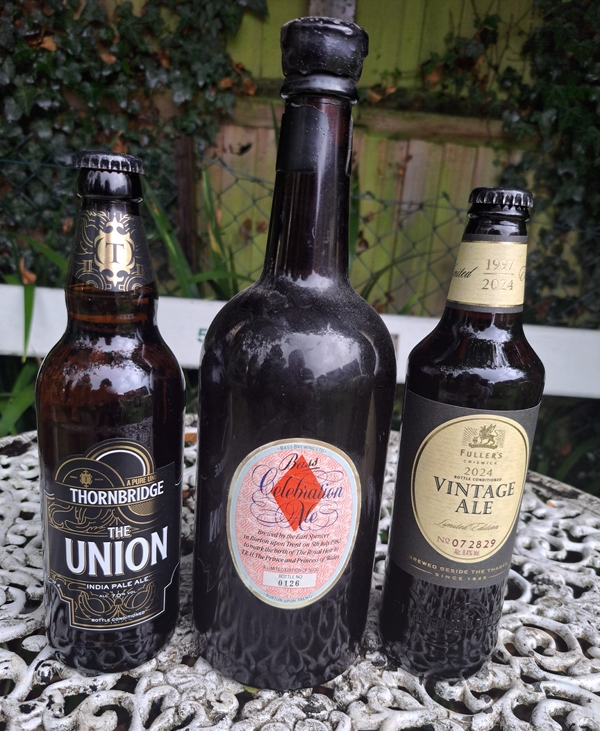Corkers! Let beer breathe
Added: Monday, September 30th 2024

The arrival of Fuller’s Vintage Ale is a cause for celebration, the beer lovers’ equivalent of the latest Bordeaux wine from France. Vintage Ale is living proof that beer can be as rich, complex and rewarding as the fruit of the vine.
‘Living’ is the key word, for Fuller’s Vintage is bottle conditioned, meaning it will age, mature and gain in character and flavour over many years. This was proved for me in 2019 when I took part in a tasting of old Bass ales in Burton-on-Trent. As well as producing regular draught beers, Bass also made bottled beers for special occasions such as coronations and royal weddings.
The beers we tasted included some dating from 1929, 1910 and even 1869. The 19th century beer was chestnut coloured and had darkened with age: the experts said it would have been brewed with just pale malt. It had a ripe aroma and palate of raisins, sultanas and plums with just a hint of hop bitterness.
These old beers are known as Corkers as they were bottled with corks but they also lived up to the jocular term for something remarkable.
A special launch last month for a group of beer writers at the Chiswick brewery for the new Fuller’s Vintage turned into a seminar on bottle conditioning. Our friendly lecturers were former head brewer John Keeling – now Fuller’s Beer Ambassador – and current head brewer Guy Stuart.
They explained in detail what happens when a beer is bottled with live yeast. Every brewer has a slightly different approach but at Fuller’s the current Vintage was brewed in February and conditioned until July when it was bottled with fresh yeast at a rate of one million cells per millilitre of beer.
The yeast continues to turn malt sugars into alcohol while consuming oxygen. This prevents the beer going stale and produces natural carbonation. By some mystical chemistry, unfermented sugars turn into fermentable ones, providing fresh food for the yeast.
All this activity under glass creates proteins and amino acids that help keep the beer in good condition. The increase in strength is small, around one per cent alcohol.
Unlike vintage wines that are always made with the same grape varieties, Fuller’s Vintage is brewed with different raw ingredients each year. The 2024 edition was brewed with pale malt and extra dark crystal malt. Three hops were used: Emperor, Pilot and a variety that’s so new it hasn’t yet got a name but has a holding number of CF299. It was bred in England but cultivated in the U.S. and, Guy Stuart says, has a pronounced peach note.
The writers also found caramel, raisin and fruit cake characteristics in the beer, along with the familiar orange note from Fuller’s yeast culture.
Vintage Ale is 8.5 per cent and the received wisdom is that beers need to be at least 5 per cent alcohol if they are conditioned in the bottle in order to give yeasts sufficient sugars to work on.
At the Fuller’s launch we also sampled several earlier editions of the beer. 2020 was brewed with double roasted crystal malt alongside pale malt and the hops were Goldings and Jester. It had marmalade, sherry, caramel and raisin notes. 2009 was made with Tipple barley malt and East Kent Goldings. Crystal malt gave it a much darker chestnut colour. It had rich fruit, caramel and vanilla on aroma and palate, with spice notes from the Goldings.
We went all the way back to 1999 with a vintage brewed with Optic malt and Fuggles hops. It had a chestnut colour with roasted malt, caramel and dark vinous fruit. 2003 was everyone’s favourite. It was made with the finest malting barley, Maris Otter, and hopped with three English varieties: Challenger, Northdown and Target. It had spicy hops, rich marmalade fruit and a long bittersweet finish.
The 2024 edition is available from selected branches of Tesco and Waitrose and also from the Fuller’s online shop.
A new beer has joined the bottle-conditioned family. The Union (7 per cent) comes from the Thornbridge Brewery in Derbyshire and celebrates their ownership of a Burton Union fermenter.
In January, when Marston’s closed its Union Rooms in Burton-on-Trent it donated one Union to Thornbridge (see “Beautiful beast now brewing in Bakewell” – What’s Brewing, July.) The Victorian system was developed to cleanse beer of yeast and produced sparkling pale ales.
The Union is an IPA and is brewed with pukka all-English ingredients: Maris Otter pale malt, crystal malt, invert sugar and Goldings and Northdown hops.
It has a pale bronze colour with a complex aroma of biscuit malt, apple and orange pith, with spice notes from the hops. Ripe fruit and honeyed malt dominate the palate with a hint of spice followed by a long, bittersweet finish with apple dominating but continuing notes of honeyed malt and spice.
As Molson Coors has stopped the production of the classic Burton bottled IPA Worthington’s White Shield, this is a splendid replacement. Lay some down for a year or a decade or two.
Louis Pasteur said his system of pasteurisation was developed for wine: beer, he said, was too delicate to withstand the heat treatment. How right he was.
Let’s keep bottled beer alive and breathing.
First published What's Brewing October 2024








